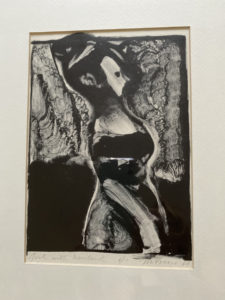 Lucky KK sent me a signed lithograph she found by the famed psychedelic poster artist Victor Moscoso. He signed it in pencil, dated 1964, and wrote the title in the margins below the image in pencil: Girl with Hairband. It’s a low edition, in other words, only ten of this image were struck, and KK found the sixth in that series.
Lucky KK sent me a signed lithograph she found by the famed psychedelic poster artist Victor Moscoso. He signed it in pencil, dated 1964, and wrote the title in the margins below the image in pencil: Girl with Hairband. It’s a low edition, in other words, only ten of this image were struck, and KK found the sixth in that series.
First, this is an early work by the artist, dated 1964. He rose to international attention during the Summer of Love (1967) because of his wonderful posters done for early icons of rock and roll. He became renowned for his vibrant, pop art posters for The Family Dog dance concerts at Avalon Ballroom, and Neon Rose Posters for the Matrix. In 1964 Moscoso, an unknown student in his twenties at the art Institute of San Francisco, created the litho “Hairband.”
Why did an art student choose a model with a Hairband? That’s Easy. Because Picasso did.
Picasso did at least seven, not a definite count, versions in linocut prints of his wife Jacqueline “au bandeau.” Thus we see the master studying the framed face of a beautiful dark-haired female with a headband or hairband. The shape of the head and the black band emphasizes the face. These studies are classics and I suspect Victor Moscoso knew many of them. A natural thing for someone studying printmaking at an art school is to try one’s hand at a study of a dark-haired female with a headband holding back long hair.
Now to the interesting part of KK’s question
What’s this piece worth? Well, Moscoso’s work as a poster artist became world famous. Vintage posters can be vintage lithographs. In other words, if you see a vintage lithographic poster, you’ll see the paint surface of the litho. If you see a machine produced poster, you won’t. And Moscoso’s bestsellers are his vintage lithographic posters.
In 2015 I helped a client sell a collection of such vintage rock and roll posters. A noted auction house came to my office from the San Francisco area to make my client an offer. So, I know how much demand we see for Moscoso’s vintage lithographic posters. In late February a Poster of John Lee Hooker (Plains of Quicksilver) dated 1967, at 14 x 10, sold for $840.
Rock and roll posters now considered fine art
Check, you might have one in an old trunk in the garage. Well respected auction houses have sold Moscoco’s posters. Wright, the Mid-Century Modern auction house in Chicago, Swann in Boston, and Freeman’s in Philadelphia love Moscoco’s posters, even though they refer to concerts mainly in San Francisco. Tessier-Sarrou, Drouot-Richelieu in Paris sold a load of Moscoso posters in 2016.
But KK has an early work, before Moscoso became known, and before he designed for rock and roll. So, I didn’t find any auction house comparable sales for anything OTHER than sales of what this artist is indeed known for, rock and roll posters. We may still find a collector of such Moscoso posters that wants to own as student work of his. No telling the value. However, I have nothing to compare it to.
Victor Moscoso As a Student
Moscoso formally trained at the best schools in this country. He became the first rock and roll artist to pull his inspirations from such luminaries as Josef Albers, a famed artist who taught when Moscoso attended Yale. Moscoso also studied at Copper Union, and the San Francisco Art Institute in the late 1950’s. He stayed on at the SF Art Institute as an instructor where I suspect he created this piece of KK’s.
As far as I ascertained, Moscoco still lives in the SF area, and has been honored by the art and illustration world. His underground comics became a trademark. He began drawing for Zap in 1968 and continued till their final issue in 2014.
Two books, KK, you might like to pick up, now we have so much time to read:
An overview of Moscoco’s work, Sex, Rock and Roll, and Optical Illusions (Fantagraphics, 2006) and the French publication of 1979 Futuropolis called Moscoso Comix #1, republished in English in 1989.